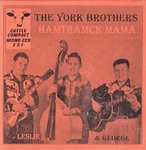


Back in the ’50s, a small batch of traditional country artists slowly shaped a new sub-genre known as rockabilly. It remained rootsy and rhythmic, but was cut with a rowdy, menacing edge. It was louder, faster and more unruly than anything before it.
That new sound not only expanded what “country music” could be, it also paved the way for punk and alternative music. From Wanda Jackson to The Cramps, from Carl Perkins to the Stray Cats — the artform has continued to mutate since its genesis.
Just listen to 1959’s “It’s Witchcraft,” by (Lansing’s own) The Blue Echoes. Then throw on any new LP by The Goddamn Gallows (another local outfit), and you’ll hear the full range of the genre. Over the years, other Lansing-based bands, like The Chirps, Flatfoot and Honest D & The Steel Reserve have all left their own distinct marks on it.
Looking beyond the Capital City, the Detroit area was also home to an early rockabilly boom. With artists like Johnny Powers who cut straightforward singles like “Long Blonde Hair” to Johnny Buckett, who recorded the cult classic “Hippie in a Blunder,” proved early on how varied rockabilly can be. And, from the start, there was no shortage of small mom-n-pop record labels pressing up these raucous tracks.
While local titan Motown Records focused on polished R&B perfection, other smaller imprints went the raw ’n’ rockin’ route. One of those early indie labels was CLIX Records, a long-defunct rockabilly imprint that pressed up amazing records by numerous troubadours who performed at whiskey-soaked saloons across the state.
Back 1959, CLIX artist Hugh Friar quickly evolved his band’s traditional country-western sound after he invested in electric guitars, a then-new technology. He also paired down his conventional five-piece acoustic outfit into an amped-up trio. With a batch of unruly tunes, Friar filled honkytonks with his new rebellious sound. “I Can’t Stay Mad at You,” a single issued in 1959, is documented proof that wild, pioneering sounds were happening here in Michigan. And, thanks to songwriters like Friar and various other ambitious record companies, a trail of Michigan-made rockabilly 45s were left behind.
A quick submersion into the CLIX catalog alone will land you at “My Hamtramck Baby,” a foot-stompin’ single by Ray Taylor. While a physical copy of the vinyl is a collectible relic, thanks to exposure via YouTube and a plenty of CD and LP compilations, the 1959 track is now considered a gem for seekers of obscure, Mitten-made anthems.
In a 2008 Metro Times article, music historian Michael Hurtt called CLIX one of the “most elusive, seamless and sought-after imprints in all of early rock ’n’ roll.”
Much of the CLIX history is also documented in the 2013 book “Detroit Country Music: Mountaineers, Cowboys and Rockabillies” by Craig Maki and Keith Cady. The 300-plus-page paperback, researched over two decades, starts in the ’40s and recounts the earliest stories and factoids from Michigan’s twangy past. The Detroit News called the book “a must for any fan of Detroit music history.”
Among many other tales, it details the amazing story of the The York Brothers, who issued 1947’s “Hamtramck Mama.” Yes, there’s yet another song about living and loving in Hamtramck, and this folklore is fully detailed in “Detroit Country Music” (University of Michigan Press). Of course, adding to that pile, the newly published “Mind Over Matter” book also heavily chronicles the Fortune Records saga and the outlying artists who made up that rustic scene decades ago.
In short, there is no lack of records and information on all of this amazing Americana Michigan manufactured, you just have to dig in.
1 comment on this item Please log in to comment by clicking here
Support City Pulse - Donate Today!
Other items that may interest you

Kingdrifter
Craig Maki and Keith Cady make Detroit Rockabilly proud.
Saturday, December 12, 2020 Report this